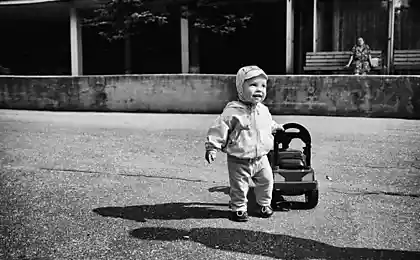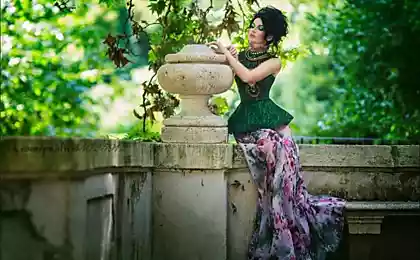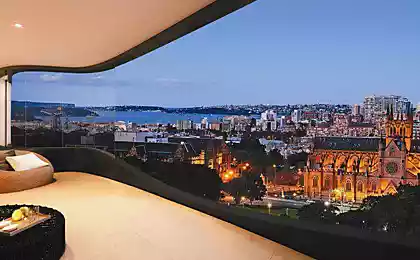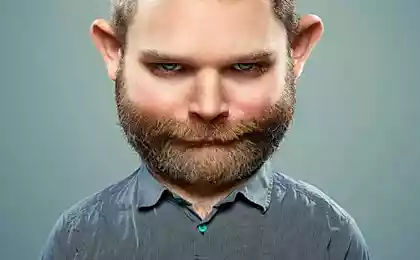723
9 years possible
12 pictures + video + letters
Mad nine robot the size of a dog on a distant buzzing cold, lifeless planet. On Earth, for his experience, worried sick, forget, remember, and it is only a phlegmatic moved from stone to stone, and studies them all shrinking set of devices. As a result, when he approached the main goal in recent years, it has remained unattainable for it, even from a distance of half a meter.
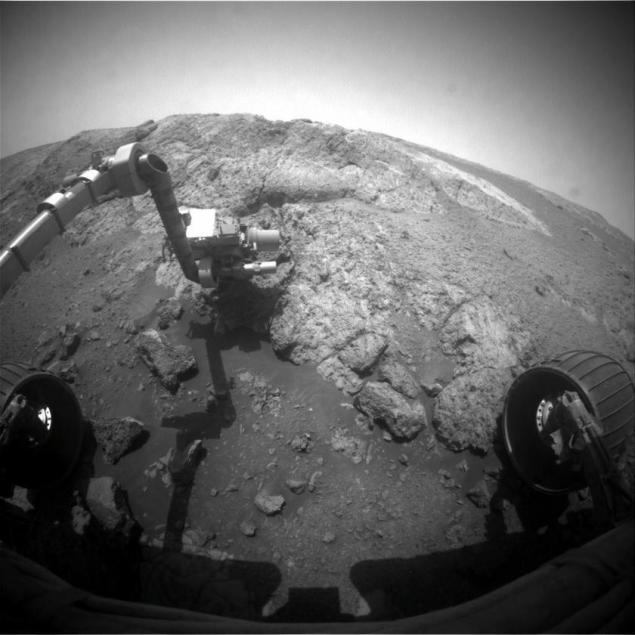
January 25, 2004 landed a second Martian rover Research Opportunity (Opportunity) on the plateau of the meridians. Its task was to detect traces of the impact of liquid water on the surrounding landscape. It is surprising that some nine years ago, NASA scientists can only hope to find some traces of water. During this time, research has leaped forward MRO satellite discovered the ice in the middle latitudes, the lander Phoenix dug water ice in the polar Raina, satellite Mars Express probed polar caps and found huge deposits of ice. All satellites discovered and explored numerous river valleys, channels, deltas. Now, no one there is no doubt that in the past Mars was warm and wet, with a dense atmosphere and much more like Earth than it is now ...
(Artistic representation of Kevin M. Gill⇗)
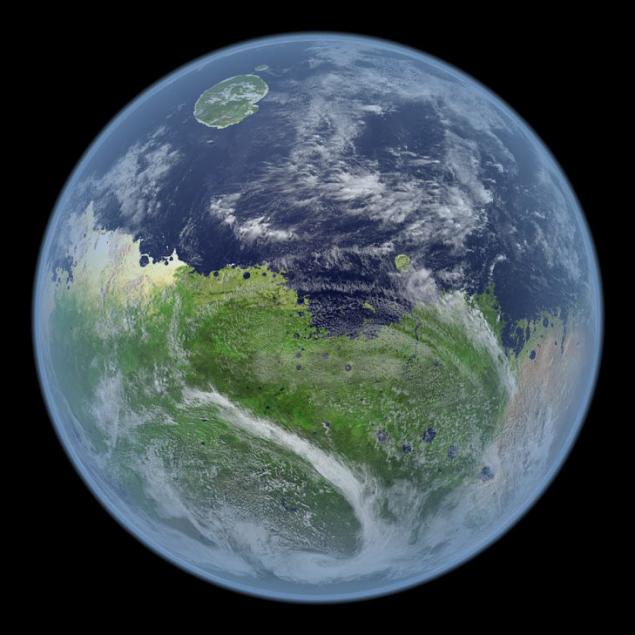
And Opportunity, completing the bulk of the program, and proved that water on Mars was not thought to be disconnected. Their Creator, he prepared a unique surprise: he explored almost the entire district and set it before the situation when there was nothing more to learn. That is, the rocks on Mars, an infinite number, but they have not brought any new information. In such circumstances, it was decided to send a rover to move many kilometers through the sandy plain to the new object of study - Endeavour crater.
Before Endeavour was then about 12 km, but the move had to detour, so as not to get bogged down in the sands. In 2008, the orbiting Mars has revolved advanced satellite Mars Reconnaissance Orbiter, he not only photographed Opportunity, and studied the surface.
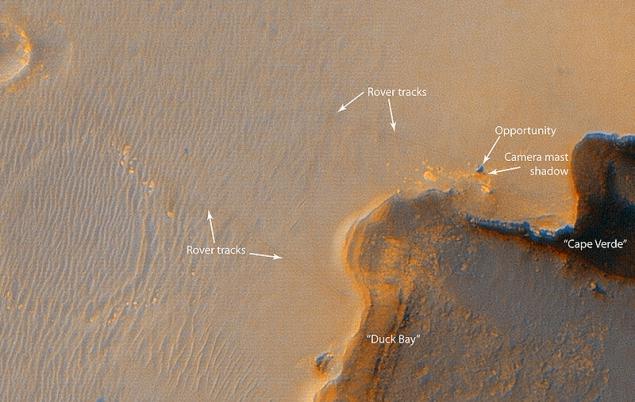
Using the appliance CRISM (Compact Reconnaisance Imaging Spectrometer for Mars) has allowed a new look on the surface of Mars. His research identified two key types of sedimentary rocks that prevail on Mars. It is found in abundance on the surface sediments having inherently sulfates (sulfur) formed under the influence of the high acidity of the liquid. These deposits are well correlated with the geological period of the Hesperides, which was selected before the MRO. This period, when there were huge volcanoes and there Valles Marineris. Sulphur emissions cause acid rain, volcanoes, and water saturated with volcanic emissions, albeit spread over the surface of Mars, but not carrying life.
But more ancient sediments - clays with compounds of iron and manganese, formed when alkaline water eroded volcanic silicate rocks. The water was very comfortable for living organisms known types. So NASA research goals have changed. If before their slogan was "We are looking for traces of water," now it became: "All of the phyllosilicates." It was necessary to determine the clay surface. It is necessary? On the one hand, to confirm the quality of the satellite detection, and the other - in the clay are more likely to preserve traces of past life. Dinosaurs NASA does not expect to find, but even the organic compounds it would be better preserved. When choosing a place of landing Curiosity, did not even consider such places where there is no phyllosilicates or smectite.
Endeavour Crater proved thereby Opportunity closest to the place where he found the required clay.

Red indicates phyllosilicates. The first portion of the ring crater named Endeavour "Cape York" and began his inspection in 2011 still. In the second half of 2012. The study includes an active phase and began to bring many new and unexpected results that planetary geologists have compared them with the new Mars rover landing.
Above alone «newberries» puzzled geologists around the world and can not come up with a clear explanation of what it is and how to appear.
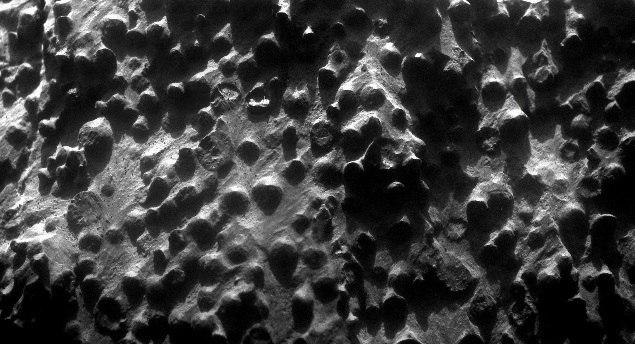
We found at the site of Kirkwood, and above them were discovered rocks that had not come across too planetary geologists. The area filled with light mineral called Whitewater Lake.
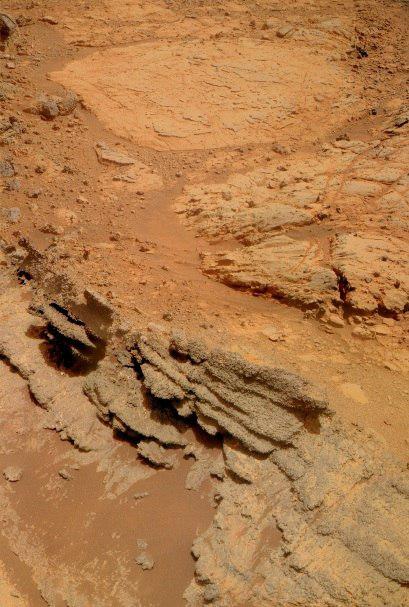
From Opportunity she went to a three-month voyage on a hill in the center of Cape York. Hill called Matijevic Hill in honor of Officer Jake Matievich JPL.

Such a motion path, NASA geologists based on the fact that they need a comprehensive understanding of the geological structure of the hill. Since it was formed by a meteorite impact, it was necessary to determine which rocks were thrown from a depth which have been modified at the time of impact, and which were introduced later under the influence of water and wind.
In a survey it was found on top of another outcrop, which had previously not been seen on Mars. Place called the Copper Cliff - Copper Cliff.
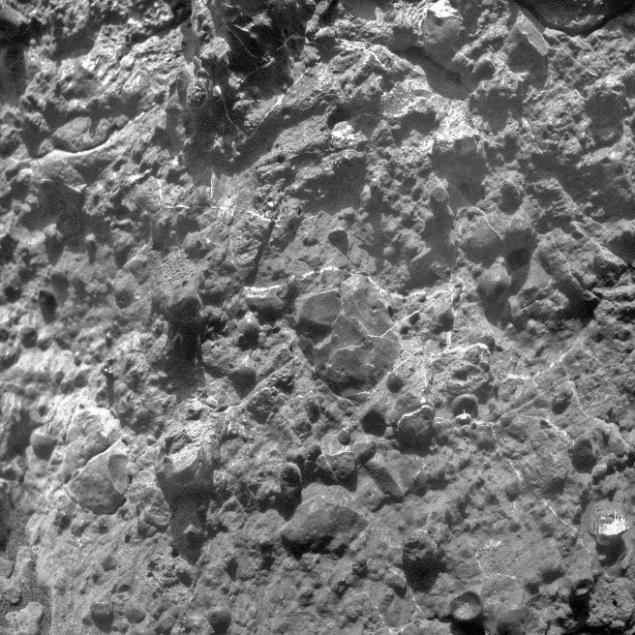
It also contains beads, like Kirkwood, but the breed is not monolithic, and cut through a network of cracks filled with white mineral. This makes it very similar to what is now studying the Curiosity in the other hemisphere, roughly on the same latitude.
After completing the round hill Matievich, Opportunity again came out to Whitewater Lake which has started a thorough examination of deposits and taking a large color panorama of the hill.
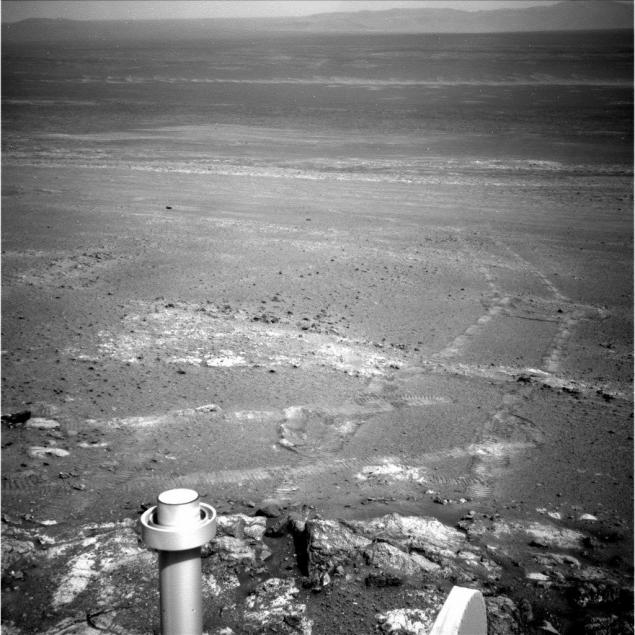
Despite the good spirits, Opportunity is not the rover that landed on Meridiani plateau 9 years ago. Its infrared thermal emission spectrometer MiniTES not functioning since 2007, when he scored the mirror dust storm, and he can not take the picture.
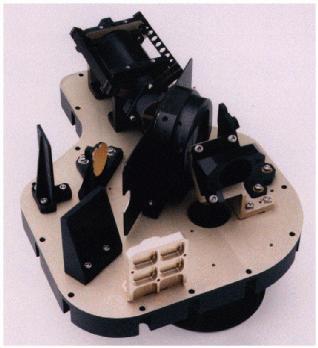
Previously, the work of the unit was analyzing the properties of rock in the degree of reflection of infrared rays. In this he resembles a satellite CRISM, which resulted in the rover to the crater Endeavour.
MIMOS II - miniature Mössbauer spectrometer, which allowed to determine the iron compounds in the rocks, is also not functioning. Applicable where Cobalt-57 has a half-life of 271, 8 days, so for 9 years, almost exhausted their resources. During winter 2011 the rover was still trying to somehow use it, but to get the results from one sample had to spend a few weeks.
It works even X-ray spectrometer APXS, but the opportunities for many studies is not enough.
Therefore, when the rover bent over the long-awaited clay, he had nothing to analyze it.
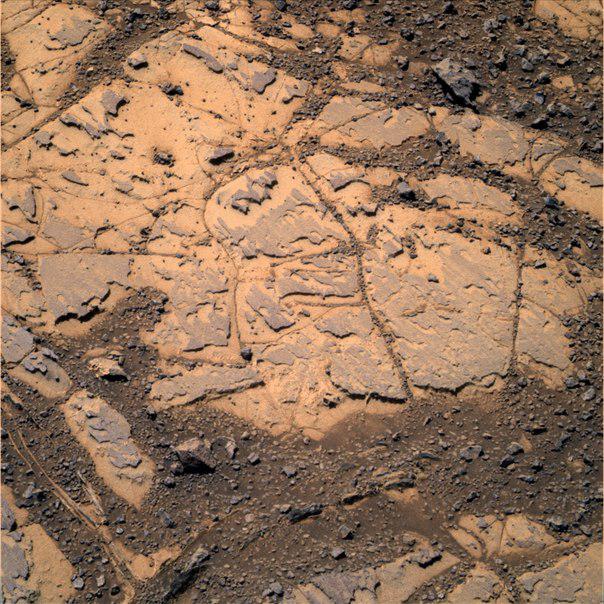
He can see it. Can dig up there opening device RAT, and on the basis of consistency, the size of the particles and the mechanical properties of the soil, scientists can say, "This pattern is very similar to clay." The satellite can is only about the card. After the round-trip time of a hill Matievich geologists have more confidence in his voice. Their main argument: "At this point, this mineral in their characteristics most similar to clay».
Meanwhile, in time for its anniversary, Opportunity sent a large panorama of the hill Matievich.
(Although the image obtained through the infrared, green and purple filters, NASA confirms that it is in these colors we would see this hill our eyes).
Panorama on GigaPan⇗
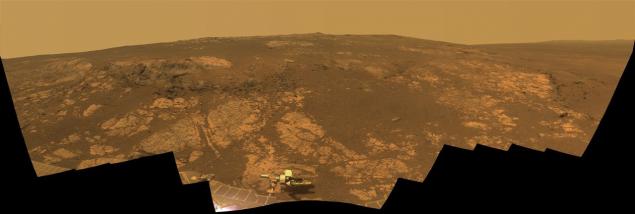
What's next? Clay found, and again sent a panorama of the rover reached their goals. Most likely, the next point of the plan is not in Cape York. The rover will continue to bypass the crater Endeavour and try to cross another milestone - to drive more than 37 kilometers and become the undisputed champion in driving beyond Earth. The previous record set yet Lunokhod 2 in 1973.
©
Source:
Mad nine robot the size of a dog on a distant buzzing cold, lifeless planet. On Earth, for his experience, worried sick, forget, remember, and it is only a phlegmatic moved from stone to stone, and studies them all shrinking set of devices. As a result, when he approached the main goal in recent years, it has remained unattainable for it, even from a distance of half a meter.

January 25, 2004 landed a second Martian rover Research Opportunity (Opportunity) on the plateau of the meridians. Its task was to detect traces of the impact of liquid water on the surrounding landscape. It is surprising that some nine years ago, NASA scientists can only hope to find some traces of water. During this time, research has leaped forward MRO satellite discovered the ice in the middle latitudes, the lander Phoenix dug water ice in the polar Raina, satellite Mars Express probed polar caps and found huge deposits of ice. All satellites discovered and explored numerous river valleys, channels, deltas. Now, no one there is no doubt that in the past Mars was warm and wet, with a dense atmosphere and much more like Earth than it is now ...
(Artistic representation of Kevin M. Gill⇗)

And Opportunity, completing the bulk of the program, and proved that water on Mars was not thought to be disconnected. Their Creator, he prepared a unique surprise: he explored almost the entire district and set it before the situation when there was nothing more to learn. That is, the rocks on Mars, an infinite number, but they have not brought any new information. In such circumstances, it was decided to send a rover to move many kilometers through the sandy plain to the new object of study - Endeavour crater.
Before Endeavour was then about 12 km, but the move had to detour, so as not to get bogged down in the sands. In 2008, the orbiting Mars has revolved advanced satellite Mars Reconnaissance Orbiter, he not only photographed Opportunity, and studied the surface.

Using the appliance CRISM (Compact Reconnaisance Imaging Spectrometer for Mars) has allowed a new look on the surface of Mars. His research identified two key types of sedimentary rocks that prevail on Mars. It is found in abundance on the surface sediments having inherently sulfates (sulfur) formed under the influence of the high acidity of the liquid. These deposits are well correlated with the geological period of the Hesperides, which was selected before the MRO. This period, when there were huge volcanoes and there Valles Marineris. Sulphur emissions cause acid rain, volcanoes, and water saturated with volcanic emissions, albeit spread over the surface of Mars, but not carrying life.
But more ancient sediments - clays with compounds of iron and manganese, formed when alkaline water eroded volcanic silicate rocks. The water was very comfortable for living organisms known types. So NASA research goals have changed. If before their slogan was "We are looking for traces of water," now it became: "All of the phyllosilicates." It was necessary to determine the clay surface. It is necessary? On the one hand, to confirm the quality of the satellite detection, and the other - in the clay are more likely to preserve traces of past life. Dinosaurs NASA does not expect to find, but even the organic compounds it would be better preserved. When choosing a place of landing Curiosity, did not even consider such places where there is no phyllosilicates or smectite.
Endeavour Crater proved thereby Opportunity closest to the place where he found the required clay.

Red indicates phyllosilicates. The first portion of the ring crater named Endeavour "Cape York" and began his inspection in 2011 still. In the second half of 2012. The study includes an active phase and began to bring many new and unexpected results that planetary geologists have compared them with the new Mars rover landing.
Above alone «newberries» puzzled geologists around the world and can not come up with a clear explanation of what it is and how to appear.

We found at the site of Kirkwood, and above them were discovered rocks that had not come across too planetary geologists. The area filled with light mineral called Whitewater Lake.

From Opportunity she went to a three-month voyage on a hill in the center of Cape York. Hill called Matijevic Hill in honor of Officer Jake Matievich JPL.

Such a motion path, NASA geologists based on the fact that they need a comprehensive understanding of the geological structure of the hill. Since it was formed by a meteorite impact, it was necessary to determine which rocks were thrown from a depth which have been modified at the time of impact, and which were introduced later under the influence of water and wind.
In a survey it was found on top of another outcrop, which had previously not been seen on Mars. Place called the Copper Cliff - Copper Cliff.

It also contains beads, like Kirkwood, but the breed is not monolithic, and cut through a network of cracks filled with white mineral. This makes it very similar to what is now studying the Curiosity in the other hemisphere, roughly on the same latitude.
After completing the round hill Matievich, Opportunity again came out to Whitewater Lake which has started a thorough examination of deposits and taking a large color panorama of the hill.

Despite the good spirits, Opportunity is not the rover that landed on Meridiani plateau 9 years ago. Its infrared thermal emission spectrometer MiniTES not functioning since 2007, when he scored the mirror dust storm, and he can not take the picture.

Previously, the work of the unit was analyzing the properties of rock in the degree of reflection of infrared rays. In this he resembles a satellite CRISM, which resulted in the rover to the crater Endeavour.
MIMOS II - miniature Mössbauer spectrometer, which allowed to determine the iron compounds in the rocks, is also not functioning. Applicable where Cobalt-57 has a half-life of 271, 8 days, so for 9 years, almost exhausted their resources. During winter 2011 the rover was still trying to somehow use it, but to get the results from one sample had to spend a few weeks.
It works even X-ray spectrometer APXS, but the opportunities for many studies is not enough.
Therefore, when the rover bent over the long-awaited clay, he had nothing to analyze it.

He can see it. Can dig up there opening device RAT, and on the basis of consistency, the size of the particles and the mechanical properties of the soil, scientists can say, "This pattern is very similar to clay." The satellite can is only about the card. After the round-trip time of a hill Matievich geologists have more confidence in his voice. Their main argument: "At this point, this mineral in their characteristics most similar to clay».
Meanwhile, in time for its anniversary, Opportunity sent a large panorama of the hill Matievich.
(Although the image obtained through the infrared, green and purple filters, NASA confirms that it is in these colors we would see this hill our eyes).
Panorama on GigaPan⇗

What's next? Clay found, and again sent a panorama of the rover reached their goals. Most likely, the next point of the plan is not in Cape York. The rover will continue to bypass the crater Endeavour and try to cross another milestone - to drive more than 37 kilometers and become the undisputed champion in driving beyond Earth. The previous record set yet Lunokhod 2 in 1973.
©
Source:

